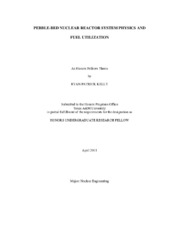| dc.description.abstract | The Generation IV Pebble Bed Modular Reactor (PMBR) design may be used for electricity production, co-generation applications (industrial heat, hydrogen production, desalination, etc.), and could potentially eliminate some high level nuclear wastes. Because of these advantages, as well as the ability to build cost-effective small-to-medium sized reactors, this design is currently being considered for construction in many countries, from Japan, where test reactors are being analyzed, to China. The use of TRISO-coated micro-particles as a fuel in these reactors leads to multi-heterogeneity physics features that must be properly treated and accounted for. Inherent interrelationships of neutron interactions, temperature effects, and structural effects, further challenge computational evaluations of High Temperature Reactors (HTRs). The developed models and computational techniques have to be validated in code-to-code and, most importantly, code-to-experiment benchmark studies. This report quantifies the relative accuracy of various multi-heterogeneity treatments in whole-core 3D models for parametric studies of Generation IV Pebble Bed Modular Reactors as well as provide
preliminary results of the PBMR performance analysis. Data is gathered from two different models, one based upon a benchmark for the African PBMR-400 design, and another based on the PROTEUS criticality experiment, since the African design is a more realistic power reactor, but the PROTEUS experiment model can be used for calculations that cannot be performed on the more complex model. Early data was used to refine final models, and the resulting final models were used to conduct parametric studies on composition and geometry optimization based on pebble bed reactor physics in order to improve fuel utilization. | en |


